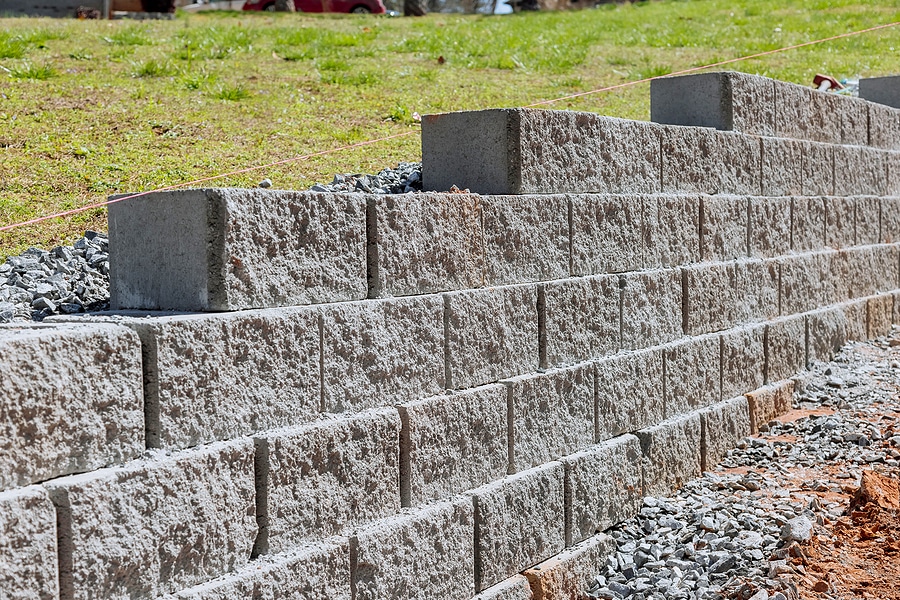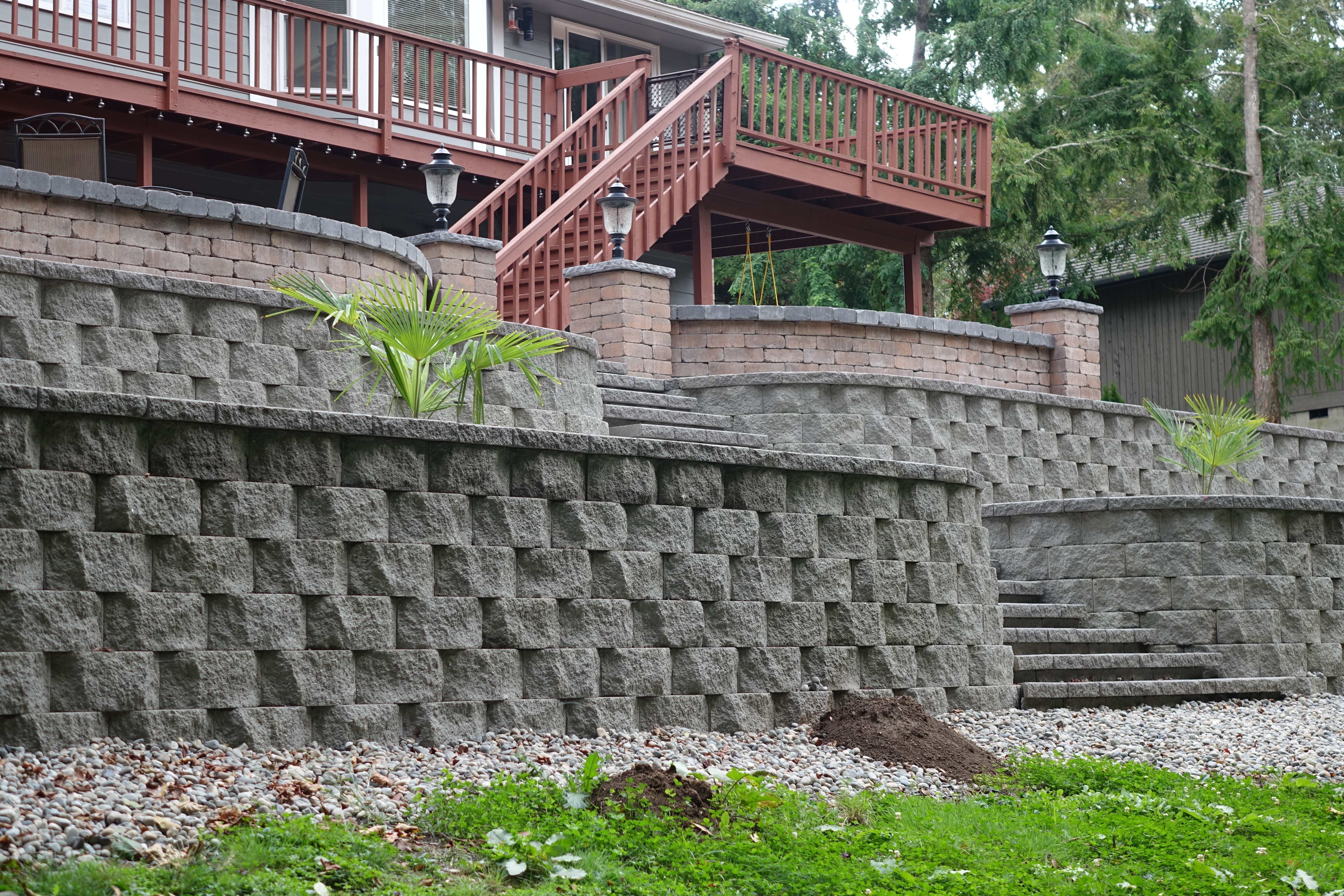Maintenance strategies to keep OKC Precision Retaining Walls standing strong for decades
Maintenance strategies to keep OKC Precision Retaining Walls standing strong for decades
Blog Article
Secret Considerations for Structure Efficient Retaining Walls in Your Lawn
When you're considering developing a retaining wall surface in your backyard, it's important to assume regarding a number of vital elements. The wall surface's objective, the materials you'll utilize, and the details dirt problems can all impact its efficiency and durability.
Recognizing the Purpose of Your Retaining Wall
When you believe about constructing a maintaining wall, consider its primary objective: stabilizing dirt and preventing disintegration. Retaining walls give essential assistance for sloped landscapes, assisting to maintain dirt integrity. You'll find they're essential in areas where water drainage may or else remove dirt, bring about pricey repair work and landscape damages.
By keeping back earth, these walls create degree surface areas for gardens, outdoor patios, or paths. This not just improves your lawn's looks yet additionally advertises far better water drainage, decreasing water pooling in unwanted locations. If you're managing high inclines, a well-constructed retaining wall can stop landslides, making sure safety for you and your residential or commercial property.
Eventually, understanding the purpose of your retaining wall will lead your design decisions and help you create a useful, sturdy framework that satisfies your needs. So, take a moment to assess your landscape; it'll pay off over time.
Choosing the Right Products
When choosing products for your retaining wall, you'll want to think about resilience, looks, and expense. Each element plays a necessary function in ensuring your wall stands the examination of time while looking fantastic and fitting your spending plan. Allow's explore just how to make the very best options for your task.
Product Sturdiness Elements
Picking the appropriate products is crucial for the long life and efficiency of your retaining wall surface, because their sturdiness directly impacts the wall surface's ability to hold up against ecological stress and anxieties. Beginning by considering your regional climate; products like concrete and rock stand up to dampness and temperature level fluctuations well. If you stay in an area susceptible to hefty rains, select products with good water drainage properties, like crushed rock or permeable blocks, to prevent water accumulation.
Additionally, consider the soil conditions on your residential or commercial property. Some products perform much better in specific soil types, so it is necessary to match them accordingly. Ultimately, understand prospective wear from parasites or erosion. Picking durable materials assurances your retaining wall surface stands solid, safeguarding your lawn for several years to find.
Aesthetic Style Selections
Resilient products not only assure your retaining wall surface's architectural integrity yet additionally play a vital duty in its visual appeal. Don't fail to remember about the wall's form-- rounded walls can create a softer look, while straight lines can feel extra structured. By very carefully choosing products that line up with your visual vision, you'll improve your exterior area while guaranteeing your wall stands strong against the components.
Cost-Effectiveness Analysis
Picking the right products for your retaining wall surface isn't simply about visual appeals; it's additionally vital for your budget plan. When choosing materials, take into consideration both upfront prices and long-term resilience.
Do not fail to remember to consider upkeep prices too (OKC Precision Retaining Walls). Some products, like all-natural stone, can add charm and call for less maintenance, while others could require normal therapies
Inevitably, consider the pros and disadvantages of each choice against your budget plan and the wall's intended function. Investing sensibly in products now can stop expensive problems later on. Choose materials that stabilize price and performance properly.
Assessing Dirt Problems and Drain
As you begin your project, evaluating dirt problems and drainage is crucial for the success of your retaining wall. Sandy dirt drains pipes well but does not have stability, while clay soil can preserve moisture, leading to pressure on your wall surface.
Next, examine the incline of your lawn. If water normally flows towards your wall, you'll need to carry out a water drainage option to prevent disintegration and pressure build-up. Take into consideration installing perforated pipes or crushed rock backfill behind the wall surface to assist in drain.
Finally, observe any kind of close-by trees or vegetation; their roots can influence soil security. By recognizing your soil problems and carrying out appropriate drainage, you'll produce a solid foundation for your retaining wall that stands the test of time.
Following Local Structure Codes
Prior to you start building your retaining wall, you need to research study local laws to assure compliance. It's important to comprehend what permits you need to acquire, as this can save you from pricey penalties or needing to redo your job. Taking these steps seriously will assist you develop a secure and reliable framework.
Study Local Regulations
Recognizing local guidelines is crucial when planning your retaining wall task, especially considering that developing codes can vary substantially by area. Begin by talking to your neighborhood structure department or community to find out regarding particular needs. Seek standards on wall elevation, products, drainage systems, and structural stability. Lots of areas have restrictions on the sorts of products you can make use of and how high you can build. You'll additionally desire to think about the zoning legislations that might affect your task. Overlooking these laws can cause pricey fines or the requirement to remodel your job. By doing your research upfront, you can guarantee your retaining wall fulfills all required codes and blends seamlessly right into your lawn.
Obtain Necessary Licenses
Once you have actually looked into local policies, the following action is to obtain the required authorizations for your retaining wall surface project. They may require particular strategies or design evaluations, especially for larger walls. Safeguarding the ideal authorizations can conserve you from costly fines or having to dismantle your wall surface later.

Planning the Style and Visual Appeal
As you commence planning the layout and appearances of your retaining wall, take into consideration how it will certainly integrate with the surrounding landscape. Think of the products you'll utilize-- rock, brick, or concrete-- and how they'll enhance your home's design and the natural environments in your yard. Pick shades and appearances that mix click to investigate flawlessly with existing functions like outdoor patios, pathways, or gardens.
Next, visualize the wall surface's shape and elevation. Rounded walls can soften a rigid landscape, while straight lines may communicate a more contemporary look. Don't forget to include plants and greenery around the wall surface for a natural touch; this can boost its appeal and incorporate it into the environment.
Finally, keep in mind functionality. Your style ought to not just be aesthetically pleasing yet additionally offer its purpose successfully. By attentively preparing these elements, you'll produce a maintaining wall that enhances your lawn's elegance while satisfying its architectural role.
Determining Elevation and Density Demands
To build a tough retaining wall, you require to precisely determine its elevation and density demands based upon the soil problems and the elevation of the incline it will support. Start by evaluating the slope's angle and the sort of dirt, as various dirts exert varying quantities of stress.
For walls over 4 feet high, take into consideration a density of at the very least 12 inches. If the wall is taller, raise the thickness proportionally to maintain stability.
Following, calculate the elevation of the wall by measuring the upright range it requires to maintain. For every foot of elevation, you ought to generally prepare for a thickness of one-third of the wall surface's height.
Always remember to account for additional aspects like drainage and backfill, which can influence your wall surface's design. Correct calculations currently guarantee your retaining wall surface stands solid and lasts for several years ahead.
Maintenance and Longevity Considerations
While maintaining your retaining wall may feel like find this a low top priority, neglecting it can result in substantial concerns in time. Routine inspections are necessary; look for cracks, protrudes, or any kind of signs of water damages. Resolving these issues early can conserve you from costly repairs later on.
Keep an eye on drain systems, as well. Clogged drains pipes can create water to develop, exerting pressure on your wall surface and compromising its stability. Clear debris and guarantee correct circulation to preserve long life.
You might additionally desire to review securing your wall to secure it from dampness and weathering. Depending upon the material, this could call for reapplication every couple of years.
Lastly, landscaping around your wall surface can sustain its honesty. Stay clear of growing big trees nearby, as their roots can threaten the structure. With aggressive upkeep, your retaining wall surface can offer you well for several years ahead.

Regularly Asked Questions
Can I Build a Retaining Wall by Myself, or Should I Employ a Specialist?
You can certainly develop a retaining wall yourself if you have the right devices and understanding. Hiring an expert warranties it's done properly, specifically for larger or more intricate structures. Consider your skill level before my website deciding.
What Are the A Lot Of Typical Mistakes Made When Structure Retaining Walls?
When building retaining walls, you could neglect correct drain, skip making use of the right products, or disregard support. These typical errors can lead to architectural failure, so take your time and plan thoroughly to stay clear of problems.
Just how Do I Know if My Retaining Wall Demands Reinforcement?
You'll understand your retaining wall surface requires reinforcement if you discover splits, leaning, or bulging. Examine for water merging behind it or dirt disintegration near the base. Address these signs without delay to avoid more damages.
What Plant kingdom Appropriate for Landscaping Around a Retaining Wall?
When landscaping around a keeping wall, take into consideration making use of low-maintenance plants like succulents, ornamental yards, or creeping ground covers - OKC Precision Retaining Walls. They'll grow in those problems and add beauty while avoiding dirt disintegration around your wall surface
Just How Can I Stop Erosion Around My Retaining Wall?
To stop disintegration around your retaining wall surface, you can plant ground cover, usage compost, and install drain systems. On a regular basis look for water build-up and change landscaping to reroute drainage far from the wall.
Report this page